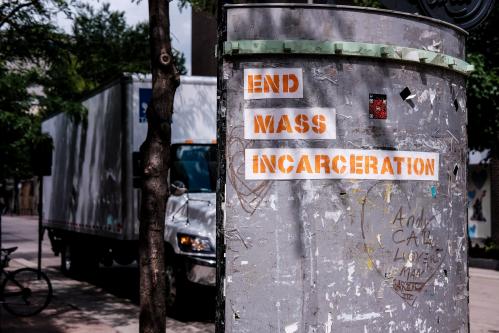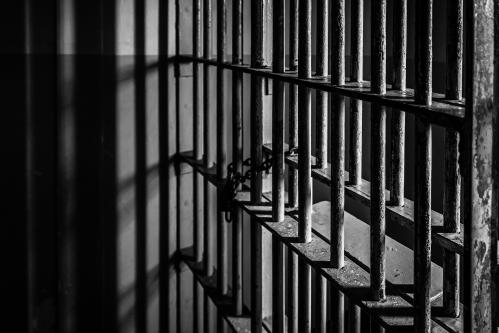In his 2000 book “The America We Deserve,” future President Donald J. Trump argued that “we don’t have too many people in prison. Quite the contrary.” Trump added, “The next time you hear someone saying there are too many people in prison, ask them how many thugs they’re willing to relocate to their neighborhood. The answer: none.”
Trump’s framing—which reflects the “tough-on-crime” rhetoric that characterized the 1980s and ’90s for Republicans and Democrats alike—has a strong emotional appeal. Specifically, it appeals to our worst fears regarding threats to our safety and that of our families and to our desire to see justice served. It’s also a framing that has provided the political justification for the racial profiling, militarized policing, and harsh sentencing that have together contributed to the rise of mass incarceration. The United States incarcerates more people (both in raw numbers, and as a proportion of the population) than any other nation in the world for whom we have data, despite the national incarceration rate being at its lowest level in 20 years. At year-end 2019, there were 6.34 million people under supervision in the U.S. adult correctional system, including people incarcerated in state or federal prison or local jail and those supervised in the community on probation or parole. Figure 1 shows the 10 nations with the highest prison population rates.

Now, 21 years after the publication of Trump’s book, crime and punishment have grabbed national headlines again because of a surge in murders nationwide. Specifically, in 2020 homicide rates increased by 29% from 2019 according to the FBI’s annual Uniform Crime Report. This year-to-year percentage increase is larger than any previously recorded since the U.S. began its national record keeping in 1960. In addition to a rise in homicide, overall violent crime increased by 5% in 2020. The five most populous cities in the U.S., New York, Los Angeles, Chicago, Houston, and Phoenix all saw increases in the number of homicides between 2019 and 2020, with Phoenix experiencing the highest percentage increase at 59%.
And while there is hope that this wave will break in 2021, many major cities are seeing percentage increases in homicides and violent crime relative to this time last year as well as relative to 2019. According to a report on 34 U.S. cities from the Council on Criminal Justice, during the first quarter of 2021, homicide rates declined from their highs in the summer of 2020, but remained higher than in the first quarter of 2020 or 2019—rising 24% compared to the first quarter of 2020 and 49% compared to the first quarter of 2019.
For many people, this uptick in homicides and violent crime is evidence that criminal justice reform is misguided or even blatantly harmful. For example, in a recent op-ed in The Hill, former prosecutor Kimberly Guilfoyle (who served as an advisor to the Trump administration) wrote: “To be clear: ‘Broken Windows’ policing works. Locking up criminals works. Strong sentencing guidelines work. And yet, Democrats want to completely throw this time-tested playbook out the window to appease their growing progressive base.”
The claim that broken windows theory works is tenuous for at least two reasons. First, as Alan Ehrenhalt notes in an article for Governing magazine, “There are a multitude of variables in play in any community that implements a new form of policing; tracing out the impact of any one of them is an extremely difficult exercise.” Therefore, a one-to-one causal argument is suspect from the very get-go, particularly absent rigorous regression techniques. Second, and more fundamentally, broken windows theory was not implemented in the same ways in every city that cited it as an influence, thereby further complicating efforts to quantify its impact or measure its effectiveness as one coherent policy framework.
The large variation in policing strategy should not be a surprise given that in the original article published in The Atlantic promoting broken windows theory, the two authors note that if community policing is rooted in the particulars of the community, there will be variation across neighborhoods. That is a potentially positive dynamic if it means the broader public sets the norms that law enforcement then upholds. But of course, lurking in that original article is all the seeds of what could (and often did) go wrong in implementation, including treating persons suffering from mental illness as obstacles to order to be removed and mention of an officer observed taking “extralegal steps” that “probably would not withstand a legal challenge.” The mixed legacy of the theory, including the most notorious policies associated with it, such as stop-and-frisk, led one of the original architects of the theory, George Kelling, to distance himself from the theory prior to his death.
But behind all this discussion is the deeper question about our overarching goals. In a recent article for City Journal (published by the Manhattan Institute, where Kelling was a scholar), Charles Fain Lehman cites James Q. Wilson (co-creator of broken windows theory) to dismiss attention on potential root-causes of crime such as poverty. Lehman quotes Wilson on the so-called causal fallacy which assumes that “no problem is adequately addressed unless its causes are eliminated.” Lehman then explains that Wilson “supported dramatically expanding incarceration—not because more prisoners and longer jail sentences necessarily deter crime (that effect is still debated today) but because incapacitation mechanically lowers the crime rate by removing would-be offenders from the streets.” For Lehman, “Why those offenders commit crimes, or how (or even if) we can rehabilitate them, is, in this context, beside the point: If our goal is to lower the crime rate, then incarcerating people works.”
Using this perverse logic, such theorists might as well argue that we should proactively arrest and lock up all males born into poverty, just to make sure we remove all statistically probable would-be offenders. After all, our colleagues find that “boys who grew up in families in the bottom 10 percent of the income distribution—families earning less than about $14,000—are 20 times more likely to be in prison on a given day in their early 30s than children born to the wealthiest families—those earning more than $143,000.” And indeed, why not take it several steps further, and in the name of public safety, place everyone in the nation under permanent probational supervision, to ensure that the crime rate remains flat?
Thankfully, we do not have to choose between efforts to decrease crime and efforts to decrease incarceration. Instead, we can pursue both outcomes simultaneously, in large part by addressing the underlying drivers of crime that Lehman and company suggest we ignore. As detailed in the next section, the last 20 years have seen a remarkable decline in both rates of violent crime and homicides as well as incarceration rates.
Things are actually getting better
In recent months, we have all seen scary graphs that depict the rise in homicide relative to the last 5 or 10 years. While these graphs are accurate, they do not tell the full story. The current homicide rate is deeply concerning, but we need to put that rate in a broader historical context. If we take a step back from the most recent headlines, we see a picture that is far more positive than many people consciously realize.
Let’s start with murder. As shown in Figure 2, which plots national homicide rates for every year extending back to 1985, the rate of homicides peaked in 1991 at 9.8 per 100,000. The rate then declined in the early 2000s and declined again in the period of 2008-2014. And even though the homicide rate increased dramatically in 2020 relative to the immediately preceding years, the 2020 rate of 6.5 is still three points lower than the peak rate seen in the 90s.

If we assume that much of the recent increase in murder is attributable to the various economic disruptions and stressors associated with the pandemic (including large upticks in the unemployment rate, which is now slowly returning to pre-pandemic levels), then we have reason to be optimistic about the near future when homicide rates should return to pre-pandemic levels. Of course, contrary to some talking points on the left, this chart also makes clear that the rise in homicides is not driven solely by the pandemic, given that rates were already higher in 2015-2019 than the rate in 2014 (the lowest depicted on this graph.) Still, even if homicide rates returned to 2019 levels or 2016 levels rather than 2014 levels, we would still be in a better place than we were in the early 2000s, to say nothing of the 1990s.
A similar story can be seen by examining national violent crime rates, again extending backward to 1985. As depicted in Figure 3, the overall rate of violent crime again peaked in 1991, at a rate of 758.2 offenses per 100,000 people, whereas 2014 is again the lowest point with a rate of 361.6. And again, despite a noticeable uptick in violent crime last year, 2020’s rate of 398.5 is still substantially lower than rates seen in the ’90s and early 2000s.

If we were implementing the perverse logic discussed earlier that recommends mass incarceration as a method for lowering the crime rate, then we might expect to see a continuous exponential rise in incarceration rates that directly correlate with this decline in murder and violent crime. But that isn’t what the data reveals. Instead, as depicted in Graph 3, incarceration rates experienced a multi-decade exponential rise, peaking in 2007, but have since been falling dramatically. Indeed, in 2019 the nation’s incarceration rate was the lowest since 1995.

It would be foolish to claim that incarceration rates and crime rates have no statistically significant relationship. And we are certainly not making that claim. But the fact that incarceration rates fell in a period overlapping with falling rates of homicide and violent crime at least suggests that we need not rely on mass incarceration as a method for reducing crime.
In addition, we think it is important to situate the rise of incarceration within the context of U.S. drug policy. Significant increases in the U.S. prison population began in the 1970s with the Nixon Administration’s “war on drugs”. In an effort to target Black people and hippies, Nixon temporarily placed marijuana in schedule one, the most restrictive drug category, rejecting a unanimous recommendation by a commission he himself had appointed. The war on drugs, which officially began in June 1971, was expanded during the presidency of Ronald Reagan. The Anti-Drug Abuse Act of 1986 established increased penalties for violations of the Controlled Substances Act and mandatory minimum sentences for some drug users, including the 100-to-1 ratio between crack and powder cocaine sentences leading to increased racial disparities in incarceration rates. Prior to the enactment of federal mandatory minimum sentencing for crack cocaine offenses, the average federal drug sentence for African Americans was 11% higher than for whites, but four years later, the average federal sentence for African Americans was 49% higher, demonstrating the deleterious effects of this law on the African American community.
Finally, while we acknowledge that the initial rise in incarceration in the early 80s and 90s matched the soaring violent crime rates of that era, and likely helped to turn the tide, we also note that the preceding context is often ignored and that the continued growth in incarceration after the ’90s far outpaced crime rates, peaking a full 16 years after the peak of violent crime and homicides. Indeed, this ought not surprise us given that the infamous 1994 crime bill which likely contributed to mass incarceration—a bill voted for by many prominent Democrats including Joe Biden (who helped write it) and Bernie Sanders—arrived a full three years after the peak of homicides and violent crime it was meant to address. In other words, our nation panicked and overreacted, contributing to the immoral and unnecessary rise of mass incarceration. That is not a mistake that we should make again.
When we connect all three charts, however, we find a story that is far more optimistic than what is currently found in the headlines of many major newspapers. And while 2020 was a rough year, if recent trends prevail, the U.S. should continue to experience relative declines in violence, even as incarceration rates continue to fall.
There’s still work to be done
We do not believe that we should or must pay the price of incarcerating more people in our nation than any other nation in the world to maintain order and safety. Nor do we think that a proper consideration of the data should push us toward embracing another surge in mass incarceration as a result of the most recent upticks in homicide and violent crime.
But there is still plenty of work that needs to be done.
First, we need to address gun violence and rising homicides as the problems they emphatically are, rather than simply assume that they will resolve automatically post-pandemic. It will take time for normalcy to be reestablished, including social norms that inform public morality and public order. One thing that broken windows theory got right in our view is that chaos and disorder invite more chaos and disorder, and that means order will need to be established (principally within civil society itself), rather than it simply emerging organically. To be clear, that does mean we need to identify violent offenders who will need to be taken off the streets and imprisoned—at least for a time, with a goal of rehabilitation for these offenders. And that also means that contrary to certain progressive talking points, we cannot fully replace police officers with social workers or strip departments of the necessary financial resources needed to patrol streets, investigate crimes, and otherwise work to uphold safety and order. Though of course, policing as institution and practice must still be held accountable, and that means we must simultaneously pursue, including drastically altering qualified immunity.
Second, we need to more fully address underlying drivers of crime to lower crime rates while continuing the recent multi-year decline in incarceration. As just one example of what we mean by this root-causes approach, we note a recent large multi-year study found a 22% reduction in homicides in Philadelphia associated with city housing repair and community clean-up projects. City leaders should explore ways of reducing economic precarity and poverty, while increasing public social cohesion, better citizen-police relationships, and a more equitable distribution of city budget. Addressing underlying drivers should also lead us to further support education opportunities within prison as part of meaningful rehabilitation and opportunity for upward mobility, including by continuing to support the recent Pell grant expansion that now includes incarcerated citizens.
Third, we need to continue the positive trend of lowering incarceration rates by identifying other crucial levers in the justice system and civil society more broadly. This work includes finding effective pathways outside of lengthy prison sentences for addressing criminal or disorderly behavior (such as alternative community service or other intervention programs particularly for juvenile offenders), identifying successful ways to rehabilitate those who are already in prison (which must include providing treatment for mental illness), and strengthening social programming and the safety net to help lower recidivism rates by helping returning citizens reintegrate successfully.
As communities slowly emerge from the pandemic, and begin to reestablish a sense of normalcy, the question of public safety will continue to be at the forefront of our politics at the local, state, and federal level. It is imperative that we employ fact-based analysis tied to reflective moral reasoning to decide what policies to implement. Fear has never been a good foundation for policymaking and neither has a self-imposed sense of fatalism. Instead, given the data surveyed in this report, we have every reason to be optimistic about the future, provided we are willing to get to work on the meaningful policy solutions outlined above. We do not have to choose between low crime rates or low incarceration. By simultaneously pursuing both low crime rates and low incarceration rates, we can make America a freer, fairer, and more peaceful nation.
The Brookings Institution is committed to quality, independence, and impact.
We are supported by a diverse array of funders. In line with our values and policies, each Brookings publication represents the sole views of its author(s).








Commentary
Dramatically increasing incarceration is the wrong response to the recent uptick in homicides and violent crime
November 2, 2021